| Pages:
1
..
16
17
18
19
20
..
27 |
SherlockHolmes
Harmless

Posts: 44
Registered: 29-7-2012
Location: Bulgaria
Member Is Offline
Mood: No Mood
|
|
Risk nitration always. If the temperature passes 30 degrees will explode. And I mean that nitro will not explode in a separatory funnel.
Sorry for my english. I am not from England. Thank you!
|
|
|
Peroksit
Harmless

Posts: 49
Registered: 5-4-2012
Member Is Offline
Mood: No Mood
|
|
Quote: Originally posted by SherlockHolmes  | | Risk nitration always. If the temperature passes 30 degrees will explode. And I mean that nitro will not explode in a separatory funnel.
|
Ok Thanks I'm understand
|
|
|
Ral123
National Hazard
   
Posts: 735
Registered: 31-12-2011
Member Is Offline
Mood: No Mood
|
|
SherlockHolmes, did you find a piece of the steel with stamped text from the bottom of the glass vessel?
For safety, not that I have much experience with NG, I'd suggest adding some acetone to the NG and then wash, add to separatory funnel, mix with
acetone and wash again. Take the NG again, let the water and acetone evaporate for a few days. You'll have predictable PH neutral NG, that can be
stored safely from months in cold, dark place. Label you bottle with warnings, you never know when it may have do be handled by someone else.
|
|
|
SherlockHolmes
Harmless

Posts: 44
Registered: 29-7-2012
Location: Bulgaria
Member Is Offline
Mood: No Mood
|
|
If I found it, I would show it. This Acetone Why? Even then dissolved in acetone mixed with other compounds will not disappear. Here's a good way to
neutralize and clear: Raw NG derived from the nitration mixture I put it in a container with larger triple volume 2% solution of sodium bicarbonate,
or better yet, potassium carbonate. Gently heat up the water bath to 35 to 40 * C and stir vigorously 5-6 minutes with a wooden stick, being careful
not to overdo - NG has the ability to form stable emulsions if overdone with stirring. Wait half an hour or more to settle exude it and put into a
water layer of 24 to 48 hours. If it is clear, change the water and let to rest one more time.
Sorry for my english. I am not from England. Thank you!
|
|
|
Ral123
National Hazard
   
Posts: 735
Registered: 31-12-2011
Member Is Offline
Mood: No Mood
|
|
Have you tried it's PH or storage stability. I washed a batch of NG several times with distilled water, ammonia and bicarbonate. It was still a little
acidic. It took 3 weeks before it got brown-green layer, stored at warm, sunny place, but not under much direct sunlight or heat.
|
|
|
SherlockHolmes
Harmless

Posts: 44
Registered: 29-7-2012
Location: Bulgaria
Member Is Offline
Mood: No Mood
|
|
With proper cleaning can be stored and more than a year.
Sorry for my english. I am not from England. Thank you!
|
|
|
dasgoose21
Harmless

Posts: 7
Registered: 28-8-2012
Location: Saturn
Member Is Offline
Mood: Ferrocious
|
|
This is not always nessecarily the case, although he did hint at a good point. If you use dark amber glass bottles and store the nitro in a cool dark
place, then it will decompose slower than if placed in a sunny place in a clear bottle. You could also keep it more stable by adding a desensitizing
agent such as dinitrotoluene, but this will also make your final product much harder to detonate.
|
|
|
I Like Dots
Hazard to Self
 
Posts: 69
Registered: 10-4-2013
Member Is Offline
Mood: frisky
|
|
Hey guys, first post. Yesterday I tried my hand at this.
6ml Sulfuric Acid
4gm ammonium nitrate
1ml Glycerine.
Everything went fine, I got almost 1ml of NG.
Today I tried to scale it up 10x. Again, everything fine (except for a rather large amount of NO2 when I added the nitrate).
After the reaction I poured it into ice water, and removed what I thought was the Glycerin layer. Washed with cold water one more time.
I left this mixture to settle out and came back in a hour to find this:

The top layer is water, then there is a clear layer, then a brown layer. The brown layer later settled on top of the clear layer. There are also
bubbles forming, and froth on top.
I have yet to neutralize the NG solution. Both brown, and clear liquids are oily, only brown burns. Im guesing dinitrate and trinitrate? Or some
ammonia compound from the dissolved NH4NO3.
Has anybody done this before that experienced this? thanks.
|
|
|
Trotsky
Hazard to Others
  
Posts: 166
Registered: 6-2-2013
Location: US
Member Is Offline
Mood: No Mood
|
|
It looks more pink than brown.
Did the solution ever get warm? The color and the bubbles sound like it may have partially runaway and the result is a lot of dissolved NOx gasses
being released.
Alternatively, as was discussed in my thread entitled nitration bath turned colors, you could have impurities in your reagents. What was the source
of your AN? I have used Walgreen's brand cold packs and crushed them down to a fine powder. However, I did not wash my AN. After washing my AN, it
was easier to dissolve into the H2SO4 and it did not turn this pink/red/brown color. Unfortunately it was harder to get it to a real fine powder.
I'm not using a ball mill, though, I'm just using an improvised mortar and pestle.
There was very little or no coloration present in small nitration baths, but larger ones, the size you've got, were just about identical in color to
your image there. However, my solution was more opaque almost. This was due to whatever anti-clumping agent they used with their prills.
What about the purity of the glycerin?
If I were you I would separate the two and then treat them both the same, clean them up properly, and see how things are. The clear could just be
unreacted glycerin perhaps, but that'd be quite a bit of unreacted material if your had the ratios correct. If it's due to an impurity or dissolved
nitrogen oxides it should go away with time, cleaning it up with remove the coloration, but I'd still work with them separately.
When you say the clear layer won't burn, do you mean that it doesn't deflagrate or that it is non-flammable? Even unreacted glycerin will burn,
according to Wikipedia some use crude glycerin as a heat source. If it's non-flammable, is it possible that you have an NG/Water emulsion? I have
heard that NG will form a stable emulsion with water if it's mixed too strongly. Given that you haven't neutralized it yet, I suspect that this isn't
the case, but if possible what's the solution then? Perhaps adding ethanol to dissolve the NG then salt it out, remove ethanol layer and evaporate
the solvent? That should work pretty well, I think.
|
|
|
I Like Dots
Hazard to Self
 
Posts: 69
Registered: 10-4-2013
Member Is Offline
Mood: frisky
|
|
Thank you for your thoughtful reply!
It was kept between 6-10 C in a ice/salt/water bath chilled in the freezer.
Glycerine was 99.5% anhydrous.
Ammonia nitrate was from a cold pack from CVS.
Sulfuric acid is 96% drain cleaner with a slight red/range tint.
When I added the nitrate to the acid, it turned a reddish color and was opaque.
The clear layer was non-flammable, even when a torch was applied (NO2 vapors were observed). This leads me to think that it was unreacted glycerine
that absorbed some water when I washed it.
The brown layer was NG .
Ok, now I think I know what happened. I rinsed it well, but there was a small amount of acid remaining in the NG, which started nitrating the
glycerine when I removed it from the ice water I rinsed it in. The remnants of Nitric acid started to react with the Glycerine as it was warming to
room temperature.
So my goof was not neutralizing it sooner. Next time I will allow the glycerine to sit in the cool nitrating bath for longer, then immediately
neutralize it after washing.
|
|
|
Hennig Brand
International Hazard
    
Posts: 1284
Registered: 7-6-2009
Member Is Offline
Mood: No Mood
|
|
Thought this might be of interest. This is what 200 g of ammonia dynamite with only 10% NG can do to over 35 tonnes of granite rock when placed in a
borehole drilled just past the center of the rock and stemmed with crushed rock. About 15 tonnes of the rock pieces have already been hauled away.
What is left is about 20 tonnes.
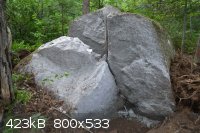
Notice the Canadian 5 dollar bill placed on the rock for scale. The rock is more than 7 feet tall.
[Edited on 3-8-2013 by Hennig Brand]
"A risk-free world is a very dull world, one from which we are apt to learn little of consequence." -Geerat Vermeij
|
|
|
Peroksit
Harmless

Posts: 49
Registered: 5-4-2012
Member Is Offline
Mood: No Mood
|
|
I would like to ask a question
The ng can freeze in nitration acid when it is between 0C-5C ? The low temp occurs a problem ?
Edit :
I have found answer of my question
[Edited on 19-12-2013 by Peroksit]
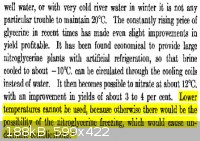
|
|
|
Hennig Brand
International Hazard
    
Posts: 1284
Registered: 7-6-2009
Member Is Offline
Mood: No Mood
|
|
During nitroglycerine production the bottle neck for me, and I am sure for others, has been the residual acid neutralization step at the end. It can
be a righteous pain in the ass to neutralize the acidity, especially if the quantity of nitroglycerine is substantial.
The problem again is that in the absence of agitation the NG simply sits on the bottom of the vessel and only the surface is exposed to the bicarb
solution. Also, if the bicarb solution is not circulated, the concentration of bicarb in the reaction zone (next to the NG) can become lowered which
also reduces the efficiency of the process. Another point is that the acids in the NG are, of course, very soluble in the aqueous solution and
agitation helps wash the NG and transfer the acid to the aqueous bicarb solution.
I was using a small centrifugal pump for a while to agitate the NG and circulate the bicarb solution, but I wanted something better. I was a little
nervous of the NG being sucked into the pump and encountering friction. I decided I wanted to build a machine to swirl or shake a flask in much the
same way as a person would do by hand. At first I was considering building a shaker, but after reading the webpage below I realized that a rocker was
probably the right machine for the job.
http://www.stuart-equipment.com/category.asp?dsl=120&
A pdf of the text from the webpage is also attached below.
A dc motor and gear train was salvaged from an old printer. Some scraps of wood and a bit of packing foam were also used. I spent about 2 hours on
this, and no money, so a much more professional and reliable machine could easily be built. It does work very well, however, even if it is just a
first crude attempt.
The motor is rated for 24 V dc, but I found that it was much too fast at that voltage even with the gear reduction. I found an old 16 V switching
power supply which seems to give about the right speed. The 16 V power supply still rocks the flask fairly aggressively (about one cycle in 0.7-0.8
seconds), but doesn't splash water everywhere. One picture of the stationary machine and two stills from a video of the machine in motion are
included below.
With warm bicarb solution, I believe this machine could do a lot of neutralizing in 10 minutes.
Attachment: Laboratory Shakers and Rockers.pdf (115kB)
This file has been downloaded 550 times
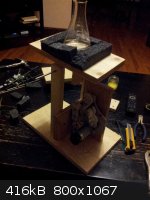 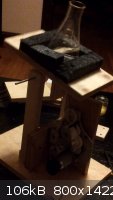 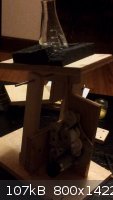
[Edited on 27-1-2014 by Hennig Brand]
"A risk-free world is a very dull world, one from which we are apt to learn little of consequence." -Geerat Vermeij
|
|
|
Ral123
National Hazard
   
Posts: 735
Registered: 31-12-2011
Member Is Offline
Mood: No Mood
|
|
I'm not sure if NG purification can be done well without solvents.
|
|
|
Motherload
Hazard to Others
  
Posts: 245
Registered: 12-8-2012
Location: Sewer
Member Is Offline
Mood: Shitty
|
|
I used to mix in acetone about half the volume of nitro glycerine.
10 ml crude NG + 5 ml of Acetone and then swirl with bicarbonate soln.
Was always too afraid of pure NG.
"Chance favours the prepared mind"
"Fuck It !! We'll do it live !!"
|
|
|
Hennig Brand
International Hazard
    
Posts: 1284
Registered: 7-6-2009
Member Is Offline
Mood: No Mood
|
|
It most definitely can. I had a fluid ounce stored for 3 years or so, which was treated with just aqueous bicarb solution, and it was still perfectly
clear (not even any yellow tint). It did of course take days of sitting in bicarb solution with occasional swirling to get it to that point.
Depending on the acetone used it might actually add contaminants, and the method will result in at least a small amount of product loss. I do like the
acetone method concept, but I still prefer the aqueous bicarb method over it.
With warm aqueous bicarb solution and good agitation residual acidity can be neutralized quite effectively and quite quickly.
"A risk-free world is a very dull world, one from which we are apt to learn little of consequence." -Geerat Vermeij
|
|
|
roXefeller
Hazard to Others
  
Posts: 463
Registered: 9-9-2013
Location: 13 Colonies
Member Is Offline
Mood: 220 221 whatever it takes
|
|
I'm so glad other people use the coffee table for prototyping also. What is your method to agitate while nitrating? And do you ever store in a
binary state or do you mix the binary/tertiaries prior to use. I'm worried about weep if I rolled up a dynamite for later use.
|
|
|
Hennig Brand
International Hazard
    
Posts: 1284
Registered: 7-6-2009
Member Is Offline
Mood: No Mood
|
|
When I first started, during nitration, I used to stir with a glass laboratory thermometer very carefully (trying not to hit the sides or bottom of
the vessel). I quickly decided that swirling would be a lot safer and from then on I tried to use vessels that allowed easy swirling. I usually store
the pure liquid. I try not to store large amounts and am very careful about it. The pure liquid is much more versatile among other things.
Edit: Rocker/Neutralizer update
I made 8 mL or so of NG just to test the rocker/neutralizer machine. What I found was that the 24 V motor had to be run at an even lower voltage than
16 V or else the NG blob stayed more or less stationary even though the flask and water were moving vigorously. This is because NG is very viscous
(resists flow) in comparison to water. I have found that at about 12 V, or 1 cycle per second of the rocker platform the NG blob rolls around quite
well. Slightly slower than this may even be better. Another thing that could be done in order to place a larger proportion of the gravitational force
on the NG blob in parallel with the bottom of the flask, and increase blob motion, would be to increase the range of motion of the rocker so that it
was tipping the flask over farther.
[Edited on 28-1-2014 by Hennig Brand]
"A risk-free world is a very dull world, one from which we are apt to learn little of consequence." -Geerat Vermeij
|
|
|
Hennig Brand
International Hazard
    
Posts: 1284
Registered: 7-6-2009
Member Is Offline
Mood: No Mood
|
|
Here are a couple of pictures of the rocker machine with better lighting. A couple of small adjustments have been made. The platform was raised above
the axle more and higher pieces of high density packing foam were fastened to the top of the platform. The foam is quite elastic and the pieces were
installed so that the flask fits very snugly in the surround made by them.
Something that wasn't obvious from the earlier pictures, and can be seen in the second picture below, are the two wooden blocks which were installed
below the platform to prevent the platform and flask from flipping right over in the event of a mechanical failure. An old computer power supply, seen
in the first picture, is used to supply 12V dc to the 24V electric motor.
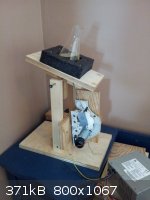 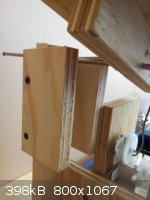
[Edited on 8-2-2014 by Hennig Brand]
"A risk-free world is a very dull world, one from which we are apt to learn little of consequence." -Geerat Vermeij
|
|
|
Ral123
National Hazard
   
Posts: 735
Registered: 31-12-2011
Member Is Offline
Mood: No Mood
|
|
What does the litmus show after the procedure, if only bicarbonate and distilled water is used?
|
|
|
Hennig Brand
International Hazard
    
Posts: 1284
Registered: 7-6-2009
Member Is Offline
Mood: No Mood
|
|
When tested, pH paper shows that the water above the NG is always slightly alkaline, due to unreacted bicarb. Never tried to directly test NG with pH
paper. My testing methods may not be the best. One thing I look for is the presence of CO2 gas bubbles rising from, or on or in, the NG. If a little
shake of the NG in bicarb solution shakes free any CO2 bubbles or causes any to become evident on the surface of the NG I conclude that the bicarb is
still doing its job of neutralizing acidity. If with a bit of shaking no CO2 bubbles are evident, and the aqueous solution above is still alkaline of
course, then I conclude the acidity is pretty much neutralized. As I have said, my methods may not be the best, but I have stored NG samples for years
with either no or very little signs of decomposition.
"A risk-free world is a very dull world, one from which we are apt to learn little of consequence." -Geerat Vermeij
|
|
|
The_Davster
A pnictogen
      
Posts: 2861
Registered: 18-11-2003
Member Is Offline
Mood: .
|
|
Aquarium bubbler.
dilute bicarb wash alternating with water wash, each agitated by a bubbler.
3-4 washes of each, each allowed to go overnight, and then dried it in a desiccator. Was stable for 3 or more years staying pH neutral and perfectly
colorless. Tasted the same before and after too 
|
|
|
Motherload
Hazard to Others
  
Posts: 245
Registered: 12-8-2012
Location: Sewer
Member Is Offline
Mood: Shitty
|
|
How long did your boner last after tasting it  ? ?
"Chance favours the prepared mind"
"Fuck It !! We'll do it live !!"
|
|
|
Hennig Brand
International Hazard
    
Posts: 1284
Registered: 7-6-2009
Member Is Offline
Mood: No Mood
|
|
I really like explosives, but so far I haven't mixed explosives and sex. You guys are really into this. 
The aquarium air bubbler idea sounds good. I have avoided air agitation for the nitration process just because of nitric stripping and moisture
addition issues. I guess the air could be dried. For neutralizing residual acidity, it's probably a pretty good process.
"A risk-free world is a very dull world, one from which we are apt to learn little of consequence." -Geerat Vermeij
|
|
|
The_Davster
A pnictogen
      
Posts: 2861
Registered: 18-11-2003
Member Is Offline
Mood: .
|
|
Hard to tell, I already had one before I tasted it...
Quote: Originally posted by Hennig Brand  |
The aquarium air bubbler idea sounds good. I have avoided air agitation for the nitration process just because of nitric stripping and moisture
addition issues. I guess the air could be dried. For neutralizing residual acidity, it's probably a pretty good process.
|
What moisture addition issues? you are either washing with aq. bicarb or water. Why would you care about dry air when it is under water?
[Edited on 8-2-14 by The_Davster]
|
|
|
| Pages:
1
..
16
17
18
19
20
..
27 |